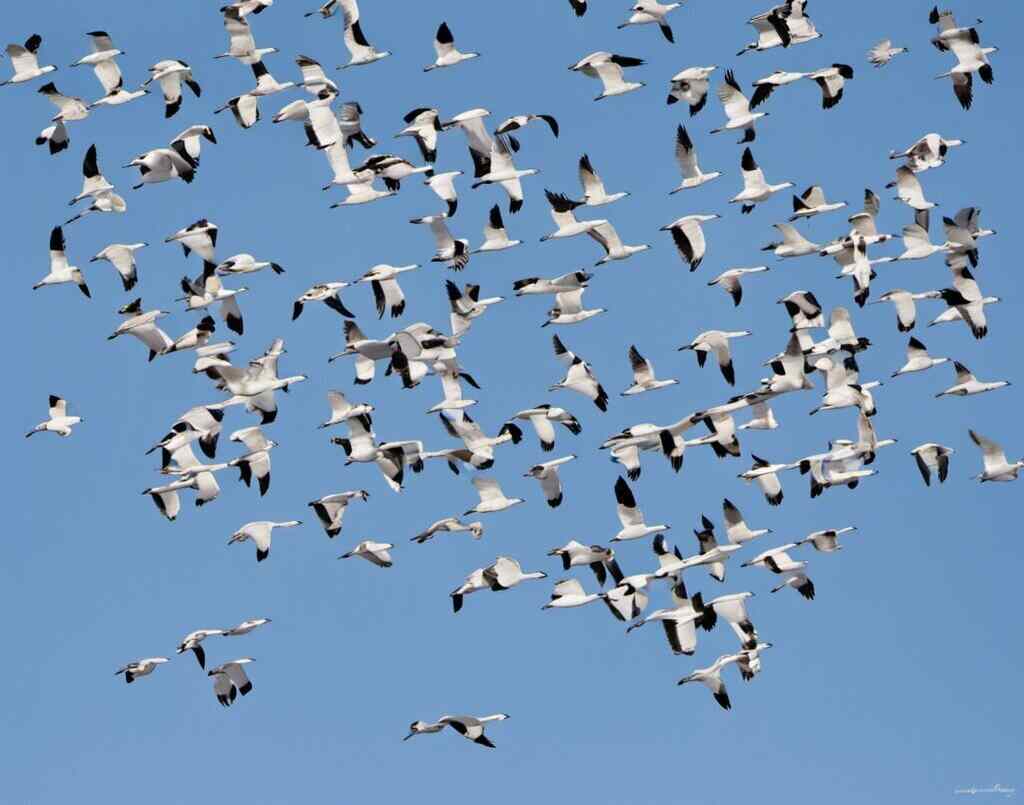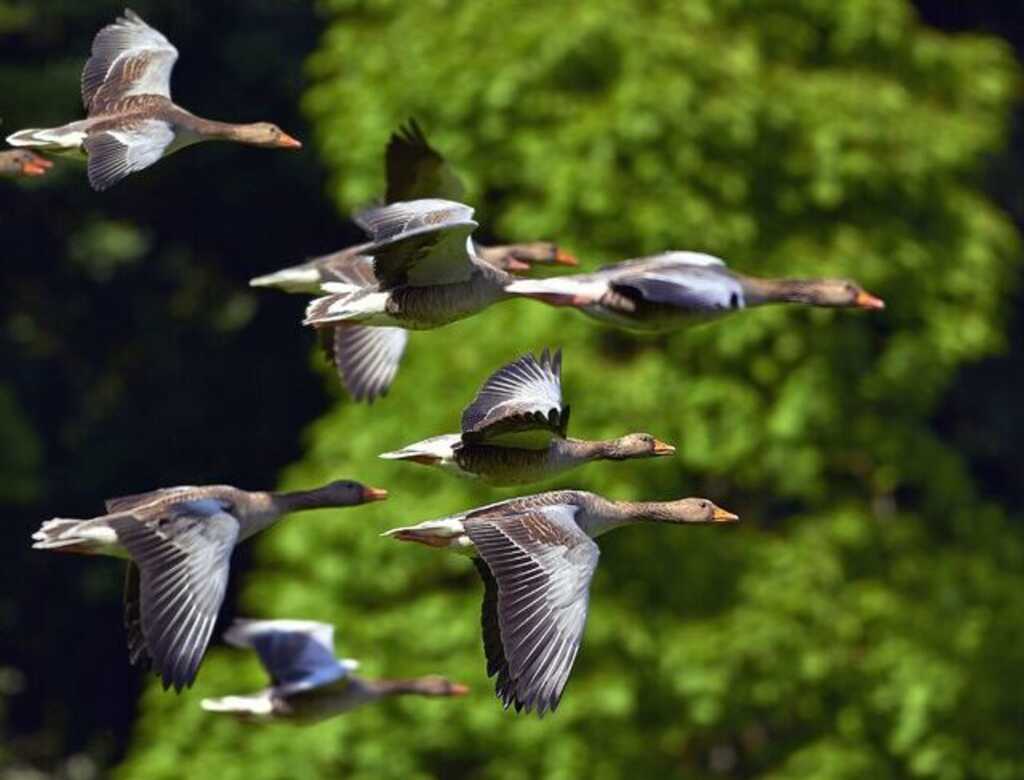As the days grow shorter and temperatures drop, many bird species embark on a miraculous journey southward, seeking warmer climates and ample food sources. This annual phenomenon, known as winter bird migration, has fascinated scientists and bird enthusiasts alike for centuries, and for good reason.
Each year, countless birds undertake journeys spanning thousands of miles, navigating countless obstacles and challenges along the way. From small songbirds to powerful raptors, a wide array of species take part in this remarkable migration, each with their own unique migration pattern and route.
Table of Contents
- 1 Key Takeaways
- 2 What Birds Migrate South For The Winter?
- 3 Understanding Bird Migration
- 4 Bird Migration Patterns
- 5 Factors Influencing Winter Bird Migration
- 6 Notable Winter Migratory Birds
- 7 Challenges and Dangers of Bird Migration
- 8 Birding Opportunities in Winter
- 9 Scientific Research on Bird Migration
- 10 Implications of Bird Migration on Ecosystems
- 11 Conclusion
- 12 FAQs: What Birds Migrate South For The Winter?
- 12.1 What is bird migration?
- 12.2 Why do birds migrate?
- 12.3 How do birds know where to migrate?
- 12.4 How far do birds migrate?
- 12.5 Do all birds migrate?
- 12.6 Are there risks involved in bird migration?
- 12.7 Can I go birdwatching during winter?
- 12.8 How does bird migration impact ecosystems?
- 12.9 What scientific research is being conducted on bird migration?
- 13 Author
Key Takeaways
- Winter bird migration is a fascinating natural phenomenon.
- The migration patterns of different bird species vary widely.
- Various environmental and biological factors influence bird migration.
- Migratory birds face numerous challenges and risks during their journey.
- Birding opportunities abound for those interested in observing winter migratory birds.
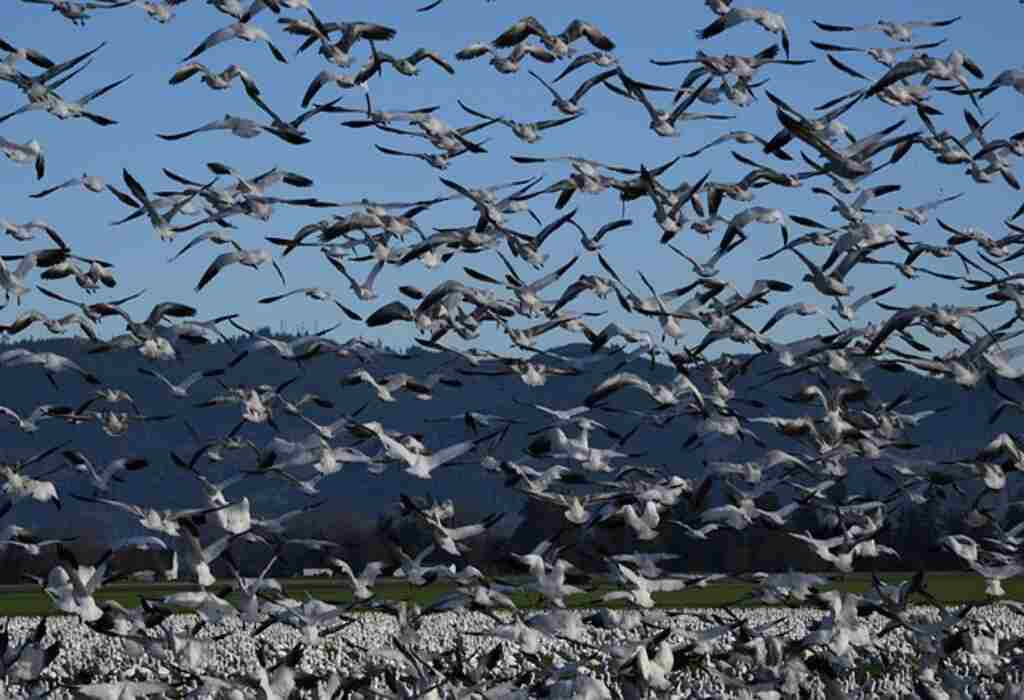
What Birds Migrate South For The Winter?
Many bird species migrate south for the winter to avoid the harsh conditions of the colder months. Some of the most well-known migratory birds include the Arctic Tern, which travels from the Arctic to the Antarctic and back each year, covering a distance of up to 44,000 miles.
Swainson’s Hawks are another migratory bird species that travel from North America to South America, covering a distance of up to 6,000 miles. Additionally, various species of warblers, sparrows, and waterfowl also migrate south for the winter.
These birds typically follow the same migration routes year after year and rely on environmental cues to know when to begin their journey. Migration is a remarkable feat of endurance and survival, and the birds that undertake this journey are truly amazing creatures.
Understanding Bird Migration
Bird migration refers to the seasonal movement of birds from one location to another, usually in search of food, nesting sites, or more favorable climate conditions. Migratory birds are often referred to as transcontinental, as they embark on long-distance journeys, crossing continents and oceans.
The migration patterns of birds are primarily influenced by environmental conditions, such as temperature, rainfall, and daylight hours. For most bird species, the onset of winter prompts the need to travel to warmer climates, which can often be found in the Southern Hemisphere.
Why Do Some Bird Species Migrate?
There are a number of reasons why certain bird species choose to migrate. For instance, the availability of food is a crucial factor, especially during winter when food sources may be scarce in their natural habitats. Migratory birds may also travel in search of suitable breeding grounds, which can often be found in areas with more favorable climate conditions.
In addition, many bird species have evolved to take advantage of seasonal variations in daylight hours, temperature, and other environmental factors. For example, some species may have adapted to changing light conditions by migrating to warmer regions during the winter, where daylight hours are longer and food is more abundant.
There is still much to be learned about the precise mechanisms used by birds to navigate their migration. However, it is believed that many birds use a variety of cues, such as the position of the sun and stars, the Earth’s magnetic field, and landmarks, to help them find their way.
In addition, some bird species have been observed to use visual landmarks, such as coastlines or mountain ranges, to guide their migration. Others may rely on their sense of smell or the sound of familiar mating calls to locate their destination.
Bird Migration Patterns
Bird migration patterns vary greatly depending on the species and their geographic location. Some birds travel thousands of miles across continents and oceans to reach their wintering grounds, while others only fly a few hundred miles. These patterns are influenced by a variety of factors, including food availability, weather conditions, and instinctual behaviors.
There are several well-known migration routes and flyways that birds follow during their journey. In North America, the most prominent routes are the Pacific Flyway, the Central Flyway, and the Atlantic Flyway. These flyways are major pathways that birds use to travel from their breeding grounds in the north to their wintering grounds in the south.
| Bird Species | Migration Pattern |
|---|---|
| Arctic Tern | From the Arctic to the Antarctic |
| Whimbrel | From Alaska to South America |
| Tree Swallow | From North America to Central and South America |
| Ruby-throated Hummingbird | From Eastern North America to Central America |
The timing of bird migration patterns is also influenced by environmental cues such as temperature and daylight. In the fall, as the days become shorter and temperatures drop, it triggers a response in migratory birds that it is time to begin their journey south. In the spring, as the days become longer and temperatures rise, it signals that it is time to return to their breeding grounds.
Some birds make multiple stops along their migration route, known as stopover locations, to rest and refuel before continuing on their journey. These stopover locations are crucial for the survival and success of the migration. Birds need to replenish their energy reserves and rest their wings before continuing their long flight.
Overall, bird migration patterns are complex and vary greatly depending on the species and their geographical location. Studying these patterns can give us insight into the behavior and ecology of birds and help us better understand our natural world.
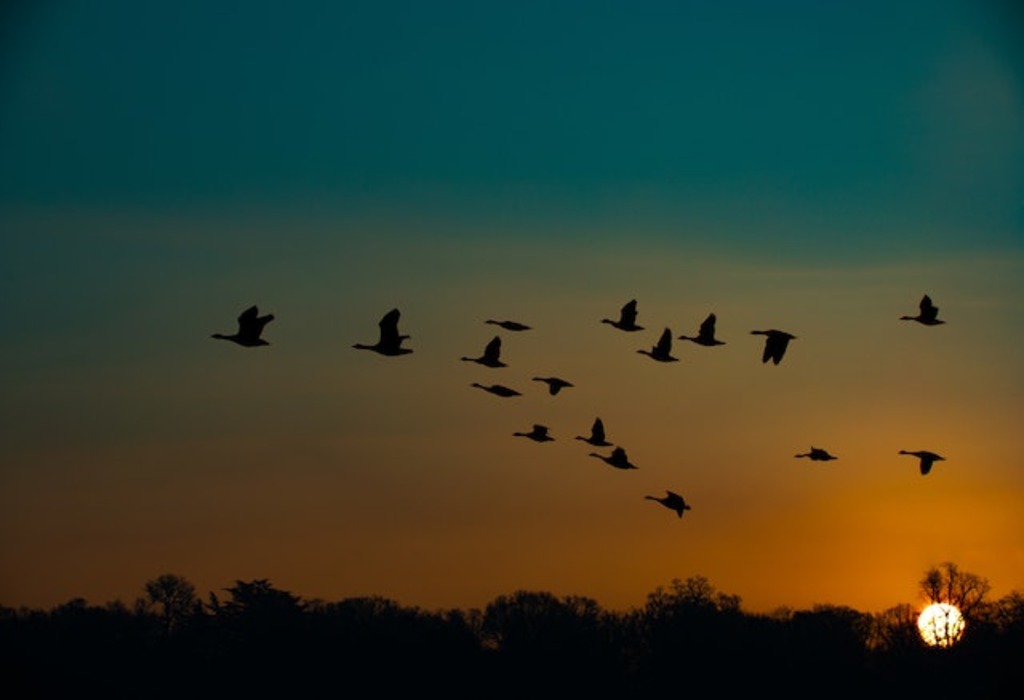
Factors Influencing Winter Bird Migration
Winter bird migration is driven by a variety of environmental and biological factors that prompt birds to travel southward in search of better conditions.
One of the primary factors influencing winter bird migration is the availability of food sources. As winter sets in, many birds are unable to find adequate food and must migrate to regions where food is still plentiful. For example, the Arctic Tern migrates all the way from its breeding grounds in the Arctic to Antarctica, where it can find an abundance of fish and krill.
Climate conditions also play a significant role in winter bird migration. Birds that are unable to tolerate extremely cold temperatures are forced to migrate to warmer regions. The Ruby-throated Hummingbird, for example, migrates from its breeding grounds in North America to Central America and Mexico, where it can find suitable temperatures and food sources.
Most birds also have an instinctual drive to migrate, which is tied to their biological rhythms. As the days get shorter and the weather changes, migratory birds become restless and feel the urge to move south.
The complex interplay of these factors results in a wide variety of winter migration patterns observed in different bird species. Some birds, such as the American Goldfinch, only migrate short distances to find food and shelter, while others, such as the Bar-tailed Godwit, undertake epic journeys spanning thousands of miles.
Overall, the factors influencing winter bird migration are a testament to the resilience and adaptability of migratory birds, as they navigate immense challenges to survive and thrive in changing environments.
Notable Winter Migratory Birds
Winter is the season when many bird species undertake long and sometimes perilous journeys to migrate to warmer regions. Here are some of the most well-known migratory birds that fly south for the winter.
| Bird Species | Characteristics | Habitat |
|---|---|---|
| Arctic Tern | The longest migrator, travels between the Arctic and Antarctic each year covering a distance of 44,000 miles | Oceanic regions |
| Bar-Headed Goose | One of the highest flying birds, flies over the Himalayas at altitudes over 29,000 feet | Mountain lakes and rivers |
| Snow Goose | Takes part in large flocks, covering distances of up to 3,000 miles between breeding grounds in the Arctic and wintering sites in the southern United States and Mexico | Wetlands and fields |
| Ruby-Throated Hummingbird | The only hummingbird species that breeds in the eastern United States, migrates thousands of miles to Mexico and Central America | Woodlands, gardens, and meadows |
These birds have unique characteristics and behaviors that allow them to survive and thrive during their migration journeys. They face numerous challenges, including the risk of predation, hazardous weather conditions, and loss of habitats. Observing these migratory birds can bring awe and fascination to those who are curious to learn more about their incredible journeys.
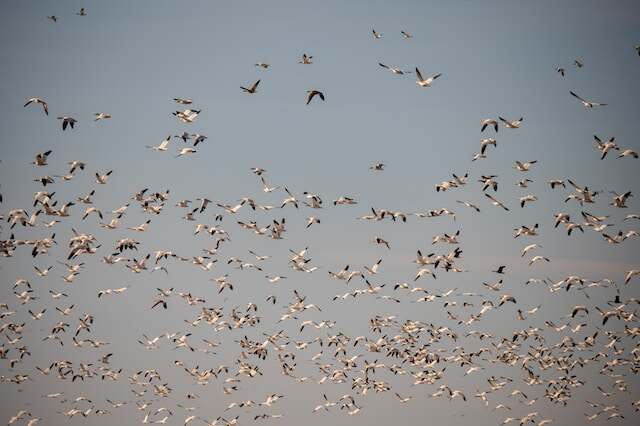
Challenges and Dangers of Bird Migration
While migration is a natural process for birds, it is not without its challenges and dangers. Migratory birds must navigate long distances, often crossing multiple countries and habitats, to reach their destination. As a result, they are at risk of encountering a range of obstacles that can impact their journey.
One major challenge is the risk of predation. Migratory birds are often targeted by predators, such as raptors and feral cats, as they fly through unfamiliar territories. In addition, birds must also contend with the physical demands of their journey, which can be exhausting. The journey can be especially difficult for young birds and those that are sick or injured.
Another danger migratory birds face is the impact of climate change. As temperatures shift and weather patterns become more unpredictable, the timing of migration can be altered. This can lead to mismatches between the birds’ arrival and the availability of food sources at their destination, putting their survival at risk.
Changes in habitat can also pose a threat. As humans continue to alter and destroy natural habitats, birds may struggle to find safe spaces to rest and feed during their journey. This can result in higher levels of stress and lower survival rates for birds.
Thankfully, there are measures being taken to help protect migratory birds throughout their journey. Conservation efforts, such as protecting habitats and reducing human impact on natural spaces, can help ensure that birds have a safe passage. By understanding the risks and challenges that migratory birds face, we can work towards creating a world where these incredible creatures can thrive.
Birding Opportunities in Winter
Winter birding can be a rewarding experience for birders of all skill levels. As migratory birds travel south for the winter, they can be spotted in various locations across the country. Here are some tips and suggestions for winter birding:
- Research bird migration patterns and flyways to determine the best locations to spot specific species.
- Bring warm clothing and gear, including binoculars and a field guide.
- Visit wetlands, estuaries, and coastal areas, which are popular stopover locations for migratory birds.
- Look for areas with food sources, such as berry bushes or bird feeders, which can attract wintering birds.
- Join a local birding group or hire a guide to increase your chances of spotting rare species.
Some popular winter birding destinations in the US include:
| Location | Notable Species |
|---|---|
| Bosque del Apache National Wildlife Refuge, New Mexico | Sandhill Cranes, Snow Geese, Bald Eagles |
| Monterey Bay, California | Pelagic birds, such as Albatrosses and Shearwaters |
| Cape May, New Jersey | Raptors, such as Peregrine Falcons and Bald Eagles |
| Everglades National Park, Florida | Wading birds, such as Herons and Egrets |
By venturing out into the winter landscape, birders can witness the awe-inspiring journey of migratory birds and gain a deeper appreciation for the natural world.

Scientific Research on Bird Migration
For decades, scientists have been studying the patterns and behaviors of migratory birds to gain a better understanding of their incredible journey. Advancements in technology have enabled researchers to track birds with increasing accuracy, providing valuable data on their routes, stopover locations, and timing.
One of the most significant breakthroughs in studying bird migration is the use of geolocators. These tiny devices are attached to a bird’s leg and record its location and activity level throughout its journey. By analyzing this data, scientists can determine the exact routes taken by birds and identify the factors that influence their migration patterns.
Another important tool in studying bird migration is radar technology. Doppler radar, which is commonly used in weather forecasting, can detect bird movements in the sky and provide insight into their flight altitude and speed. This information is useful in predicting and mitigating potential collisions with airplanes or wind turbines.
Scientific research on bird migration has also revealed the important role that genetics and instinct play in guiding birds on their journey. Studies have shown that some birds are born with an innate sense of direction and the ability to navigate using the earth’s magnetic fields. Other birds may rely on visual cues or landmarks to guide them.
Overall, the scientific study of bird migration has provided valuable insights into the behaviors, patterns, and ecological significance of migratory birds. Continued research is essential in protecting these species and the ecosystems they inhabit.
Implications of Bird Migration on Ecosystems
Bird migration is not just a remarkable natural phenomenon, but it also has significant implications for the ecosystems they call home. The arrival and departure of migratory birds affect food chains, nutrient cycling, and overall biodiversity.
One of the most crucial roles that migratory birds play in ecosystems is as seed dispersers. Many bird species that migrate to tropical or subtropical regions consume fruits with seeds that cannot germinate without first passing through the digestive system of a bird. As these birds migrate and excrete seeds along the way, they distribute and plant new vegetation across vast territories.
Migratory birds also help regulate populations of insects and other small animals by preying on them. This not only benefits the survival of their own species but also prevents these organisms from overpopulating and damaging their habitats through excessive feeding or altering landscapes via soil disruptions.
Furthermore, migratory birds provide other animals with valuable food resources at critical times during the winter. For instance, raptors like owls and falcons that live in colder regions rely heavily on migratory birds for sustenance during the winter months when prey is scarce.
Overall, migratory bird populations play a vital role in maintaining the balance and health of ecosystems globally. As such, it is crucial to study and protect these species and the habitats they rely on for survival.
Conclusion
Winter bird migration is a remarkable natural phenomenon that has fascinated humans for centuries. The journey undertaken by migratory birds is a testament to their resilience and survival instincts, as they navigate long distances and overcome numerous obstacles along the way.
Understanding bird migration and the factors that influence it has been the focus of scientific research for many years. Technological advancements have allowed us to track bird migration routes and gain valuable insights into this complex behavior.
Winter bird migration plays a crucial role in maintaining the balance of ecosystems. The arrival and departure of migratory birds have a significant impact on food chains, seed dispersal, and biodiversity.
As birdwatchers, we have the unique opportunity to witness this awe-inspiring event and appreciate the beauty of these winged creatures. By visiting popular winter birding destinations and observing migratory birds in their natural habitats, we can gain a deeper understanding and appreciation for their journey.
Winter bird migration is a testament to the resilience and adaptability of nature. Let us continue to protect and appreciate these magnificent creatures and the incredible journey they undertake every year.
FAQs: What Birds Migrate South For The Winter?
What is bird migration?
Bird migration is the regular seasonal movement of birds from one location to another. It is a natural phenomenon observed in many bird species, where they travel long distances in search of food, breeding grounds, and suitable habitats.
Why do birds migrate?
Birds migrate for various reasons, including the availability of food, changes in climate and weather patterns, and the need to find suitable breeding grounds. Migratory birds often travel to warmer regions during the winter months to find better food sources and avoid harsh conditions.
How do birds know where to migrate?
Birds have an incredible ability to navigate during migration. They use a combination of visual cues, celestial landmarks, magnetic fields, and other instinctual behaviors to find their way. Some bird species also rely on their memory of previously traveled routes.
How far do birds migrate?
The distance that birds migrate varies depending on the species. Some birds may only travel a few hundred miles, while others can cover thousands of miles in their migratory journey. The Arctic Tern holds the record for the longest migration, traveling from the Arctic to the Antarctic and back each year, covering a distance of over 44,000 miles.
Do all birds migrate?
Not all bird species migrate. Some birds, known as resident birds, stay in their breeding grounds throughout the year. Migration is more common among birds that rely on specific food sources or breed in regions with extreme weather conditions.
Are there risks involved in bird migration?
Yes, there are several risks and dangers involved in bird migration. Migratory birds face threats such as predation, exhaustion, adverse weather conditions, and loss of suitable habitats along their routes. Conservation efforts aim to mitigate these risks and protect migratory birds throughout their journey.
Can I go birdwatching during winter?
Yes, winter is a great time for birdwatching, especially in areas that attract migratory birds. You can observe a variety of species that are not present during other seasons. Research popular birding destinations and keep an eye out for species that are known to migrate during winter.
How does bird migration impact ecosystems?
Bird migration plays a significant role in ecosystems. Migratory birds contribute to seed dispersal, pollination, and pest control. Their arrival and departure also affect food chains and overall biodiversity, making them important indicators for the health of ecosystems.
What scientific research is being conducted on bird migration?
Scientists conduct various studies on bird migration to understand its patterns, routes, and behaviors. They use advanced tracking methods such as satellite telemetry and geolocators to monitor bird movements. This research helps in conservation efforts and provides valuable insights into the natural phenomenon of bird migration.

